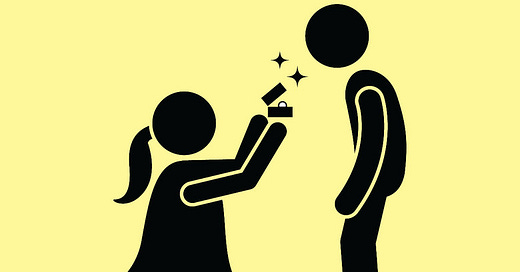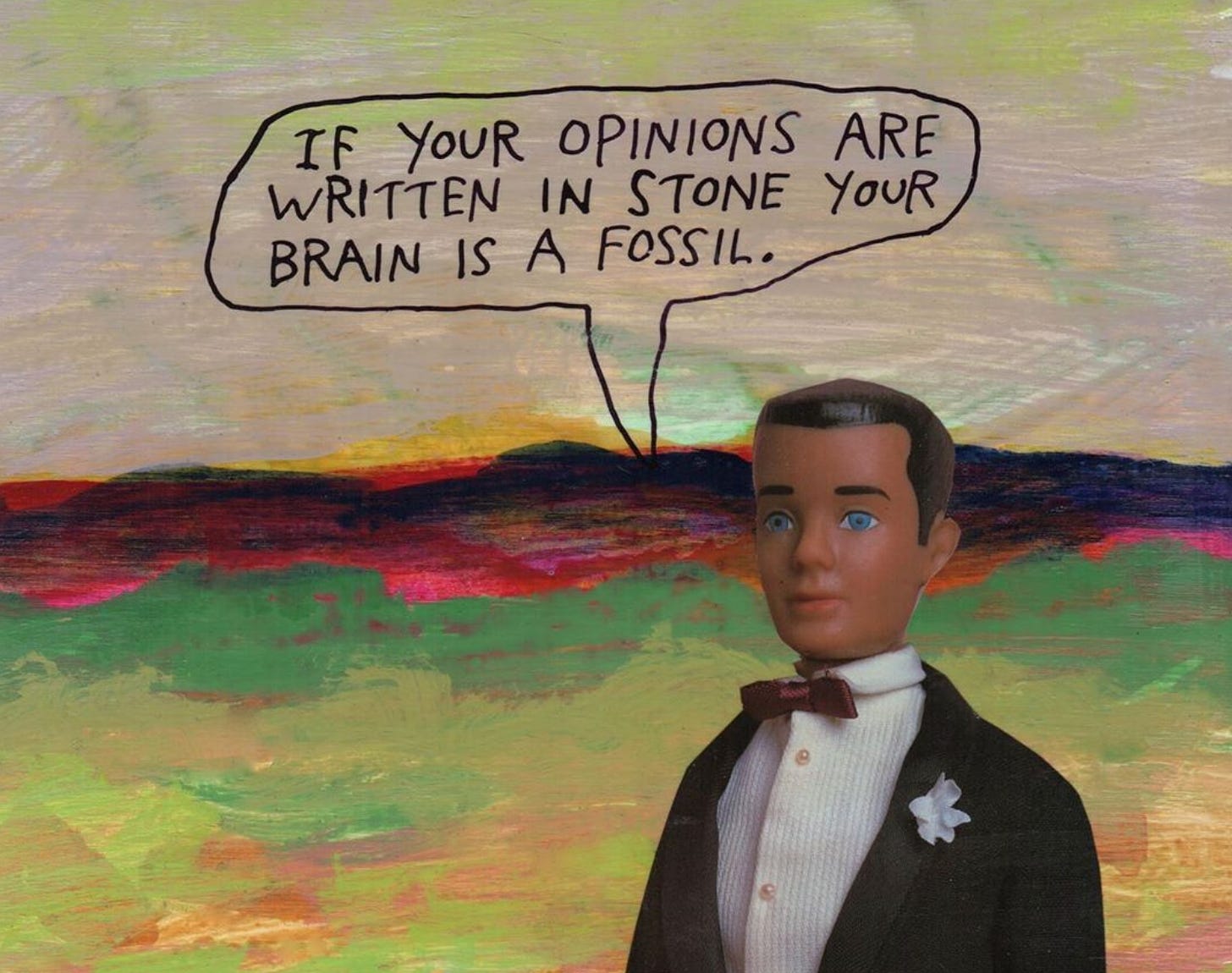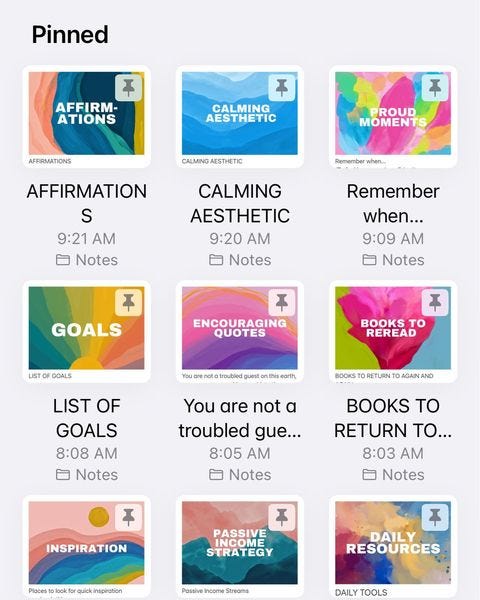Throwback Edition: Our Narrow, Gendered Lens
Plus, how the hell has Danielle Steele managed to write 179 books, notes on work, and a Tiny Desk audition you need to watch
Dearest Readers,
As I write this note. I’m nearing the end of a week trip to Florida. I came down to see my family because I wasn’t able to make it for Christmas and also because my skin was on the brink of becoming entirely translucent. It’s been a refreshing, hectic time—coincidentally, the first time since going freelance where I had five deadlines in one week—but I’m glad I made the trip.
For those of you who are new here, every so often, I’ll send out a Throwback Edition to re-circulate an old essay that deserves a second wind. This one has always been a favorite of mine, and as I re-read it I couldn’t help but think about how much my mindset has expanded since writing it. When I wrote this in September of 2020, I wasn’t out as bisexual yet and I hadn’t officially begun dating women alongside men. I thought the idea presented in this essay was on the radical side (in fact, I got in a few spirited debates after sending it out). There’s a follow-up essay coming down the line about the whole new layer of gender dynamics you discover when you begin dating both sexes and assuming new roles, but I’ll save that for another day.
I was watching the new season of ‘Love in Blind’ last night (the best trash TV there is) and thought about this essay. So far, it is an all-heterosexual show in which strangers get to know each other sight unseen with the intention of one interaction ending in a marriage proposal. In every case, the man proposes to the woman—of course, he does. And I wondered how the internet would react if, for once, that norm was flipped on its head.
That’s all for now! I updated a few of this week’s content recommendations to make them more timely, but there are also a few old goodies in there. If you haven’t opted for a paid subscription yet, please consider doing so! Paid subscriptions allow me to continue to pour time and energy into reading/writing/researching for this newsletter. And a quick housekeeping note: Starting in March, paid subscribers will have access to the full edition every week, while free subscribers will have access to the intro essay every week and one full edition each month.
A Note From the Editor
I’ve been thinking a lot about gender this week, reciting old tropes and challenging my own experiences and assumptions under a more fastidious gaze. During one of these reflections, I recounted a conversation I had last year with one of my most brilliant friends. We were having dinner outside in the West Village, enjoying salads and french fries and the chill in the end-of-summer air when the topic of marriage came up. I probably asked her something boring, like “do you think you’ll marry him?”, partly because I was interested but also because I feel a covert obligation to ask such things to my friends who have been with their partners for multiple years. Her answer was refreshing and level-headed: yes, probably, but only after she accomplished certain things in her career, and by no means did she want a wedding ring. It was an outdated tradition, she insisted, one that she felt no attachment to.
I was baffled, impressed, and probably a little intimidated. I’ve always classified myself as a feminist, but I had not yet considered the inherent lopsidedness of the traditional engagement ring, and the traditions associated with heterosexual engagements in general. In these instances, the man is almost always the inciter; he carefully plans for the moment, coordinating with family and friends and photographers, he purchases the perfect ring, perhaps with the help of a pushy sister or a steadfast best friend, and the woman waits. She waits and waits and waits. Maybe she quietly frets over the timing, attempting to drum up a sense of feigned nonchalance as she scrolls past yet another photo of The Perfect Engagement on Instagram. And even if her patience grows thin, she probably doesn’t consider taking matters into her own hands, because what would that even look like?
This one-sided dynamic doesn’t start and end with engagements, rather it is an inevitable endpoint to the way we are conditioned to understand our place in the framework of a gendered society. From early on, most heterosexual romantic encounters rely on male-led initiative. In high school, the boy typically asks the girl to prom, a notion that is constantly reinforced by movies and pop culture à la Never Been Kissed. The man asks the woman on the first date, and at the start of a monogamous relationship, the man is most often the one to bring up the “exclusive,” “in a relationship,” “boyfriend and girlfriend” talk. Being on the woman’s end of these weighted transactions for the past twenty-eight years, I can at least speak for myself when I say that in a lot of cases, the woman doesn’t innately want to wait, the same way I assume that the man doesn’t always want to be the sole proprietor in a relationship’s progress. A guy friend of mine once said, “in a relationship, the man is constantly pushing forward and the woman is either accepting or rejecting it.” It didn’t bother me at the time because it was and still is true, but I’m beginning to question why this has to be the case, and why I’ve accepted it at face value for so long.
How can we insist on equality while simultaneously buying into such antiquated notions without further prodding? How can we think once a ring is secured and home is purchased and children are born, things will magically become more equitable, despite the fact that our very foundation was built upon haphazard grounds that grant one party the power to choose when and how and where, while expecting the other party to patiently wait? I suppose I was of that frame of mind when, earlier this year, I tried to enlist a handful of my girlfriends to send their partners flowers for Valentine’s Day. Like a true type-A Virgo, I even made an instructional sign-up sheet, and you may not be surprised to hear my efforts didn’t go very far. “He would kill me,” one friend, whose partner works in a male-dominated Wall Street office, texted. “Cute idea,” another commented halfheartedly. In the end, I became discouraged and distracted, and I did not send my partner flowers at his job — though in retrospect I wish I would have, as it may have been the last Valentine’s Day involving a brick-and-mortar office for some time.
We take down Confederate monuments when we realize they are no longer a reflection of the world we are currently living in. We expect the courts to make rulings and Congress to write legislation that mirrors the core values we hold as a modern society, and those landmark decisions have granted millions of Americans greater freedoms: the right for LGBTQ people to marry, the right for women to choose what to do with their bodies, the right for transgender people to be protected from discrimination in the workplace. We are, ideally, constantly moving forward as a collective, expanding our points of view and challenging the way things have always been. Maybe it’s time to apply that same level of modernized scrutiny to gender roles in romantic relationships. Perhaps we are long overdue for an update.
While many individuals have a fairytale attachment to the notion of declaring eternal love in the form of a diamond, consider the troublesome history of engagement rings. Back when virginity was a prized commodity amongst prospective brides, a woman could sue a man who didn’t follow through with his engagement under “Breach of Promise” laws. The argument was that the man had made her a less appealing prospect by taking her virginity without committing to her, and now he owed her. When those laws were struck down, engagement ring purchases skyrocketed. The engagement ring was, in essence, virginity insurance — if your fiance decided to have pre-marital sex with you and didn’t follow through with his commitment, or if he married you and later changed his mind, at least you would have an expensive ring as collateral. It doesn’t sound so romantic when you put it that way.
Cheers, my dears, and I’ve got a question or two for you:
Do you know any heterosexual women in your life who have proposed to their partners? Please share the story with me!
Do you know of any pop-culture references in which a woman proposes to a man? If so, please share them with me. If not, do you think displaying such a dynamic (say, in a Disney movie) would be useful?
How do these nuanced dynamics manifest in same-sex relationships, or relationships involving one or more transgender persons, or gender-nonconforming person? Are these problems purely heteronormative?
Three Pieces of Content Worth Consuming
How the Hell Has Danielle Steele Managed to Write 179 Books? You probably know Danielle Steele from the paperback spines on your grandmother’s bookshelf, but did you know she is an otherworldly writing machine? I haven’t stopped thinking about this piece since I read it last year, as there is something inherently interesting about the various daily rituals of writers. I especially like reading about what writers eat in the morning: one piece of toast and iced decaf coffee followed by mini chocolate bars for Steele, a can of ice-cold morning Coca-Cola with a straw for Joan Didion. After reading this piece, Google Danielle Steele’s net worth, and then try to tell me you can’t make money as a writer. Looks like all of her 22 hour days have paid off!
Notes on Work. I've read so many essays in the new Great Resignation canon about our tendency to overwork, and they all come to the same conclusion of which I approve: Overworking is bad, we need to take out life back. This one was refreshing in that it does not land where the others land. told in a non-new Yorker style list format, this essay discusses the important nuance of immigrant erasure and how living as an immigrant affects your level of worth ethic. After reading I sat at my desk with my mouth open, in awe of what the author has been able to accomplish, deeply sad that she pushes herself so hard, partly envious that she's found a way to be so proficient.
How to Foster the Japanese Concept of ‘Shoshin’. This shouldn't come as such a surprise, but somehow it was for me: the more you think you know about a subject, the more close-minded you tend to be about it. The concept of shoshin is rooted in the idea of approaching life from a place of humble intellect versus fixed expertise, thus creating more opportunities to learn without wrongly assuming you know more than you do. This handy guide suggests the first step to developing shoshin is testing your knowledge on a subject you think you know a lot about by trying to explain it aloud to others — the idea being that you may not know as much as you think you know. One of my favorite quotes from the guide:
‘In the beginner’s mind there are many possibilities, but in the expert’s there are few.’
Perhaps You Should… Redirect Your Screentime
I’ve had this idea flagged for weeks now and haven’t gotten around to it, but am interested in giving it a try. To cut her screentime in half, one woman used her savvy design skills to create her own person “feed” in her notes app by creating a handful of encouraging, inspiring lists that she knew she’d want to click on. Instead of going straight to social media when she opens her phone, she visits this feed instead. I’m sure you can imagine the results are much more fulfilling–and shorter—than seeing another video of a baby cow on Instagram. If you try this, let me know!
**Bonus Content** (An Absolute Must Watch)
You know when you drive past an accident and you know you shouldn’t slow down to look at it, but you do it anyway out of some strange, uncontrollable instinct? That is exactly how I felt the first time I watched this NPR Tiny Desk audition last weekend. I’ve watched it about six more times since then, and it is raw, mesmerizing, a little bit uncomfortable, and altogether charming. Who would’ve guessed that I love lo-fi, spoken word rap? You are now all my little peach scones.
A Quote From A Book You Should Read:
“The problem with gender is that it prescribes how we should be rather than recognizing how we are. Imagine how much happier we would be, how much freer to be our true individual selves, if we didn’t have the weight of gender expectations.”
-We Should All Be Feminists by Chimamanda Ngozi Adichie
This newsletter is best served with a side of conversation, so drop your opinions, reflections, and thoughts in the comments below and let’s get to talking.
Or, share the most thought-provoking piece from today’s edition with someone you love, then call them up to discuss, debate, and percolate. As a wise woman once said, “Great minds discuss ideas.”








Hi Meghan - longtime reader, first-time commenter.
I wanted to draw your attention to some of your language here:
"when you begin dating both sexes" is kind of an awkward thing when the essay is allegedly against a narrow gendered lens! When you begin dating people who aren't men might be a more inclusive way to put it.
And this: "How do these nuanced dynamics manifest in same-sex relationships, or relationships involving one or more transgender persons, or gender-nonconforming person? Are these problems purely heteronormative?"
Seems to imply that trans people are, by definition, not heterosexual. Trans people are on the Kinsey scale too! I know a lot of bi/pan trans folks, but I also know trans folks who are 100% heterosexual. Trans people and "gender-nonconforming" (if you mean nonbinary, we tend to prefer nonbinary, although we are of course not a monolith and I don't speak for everyone who isn't cis).
Those two turns of phrase cast the essay, despite claiming to be about expanding ideas of gender, as believing in only two genders, both of which are cis. Those lines are very othering to trans and nonbinary readers, and I hope that that was not the intent.
I'm a nonbinary, bisexual femme who proposed to my asexual husband (I also have a girlfriend, who's bi). We don't fit in the rigid framework you've constructed, so I don't know if you want that data, but I offer it anyway.
I don't need a response here, we're all busy; I just wanted to point that out because I think you probably didn't intend it to come off that way and might want to course-correct in future! Hope you have a great day.